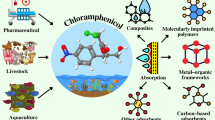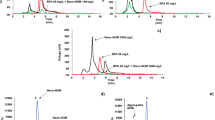Abstract
Nitrous oxide reductase from Wolinella succinogenes was tested for benzyl viologen cation (BV+)-chlorinated methane oxidoreductase activity, using di-, tri- and tetra-chloromethanes, and for the inhibition of BV+-N2O oxidoreductase activity by these chloromethanes. No BV+-chlorinated methane oxidoreductase activity was detected. Any such activity, if it exists, must be less than 0.1% of the BV+-N2O oxidoreductase activity of the enzyme. Inhibition of the BV+-N2O oxidoreductase activity by dichloromethane was detected and was apparently reversible and non-competitive, as is the case with the small metal-ligand type inhibitors of the enzyme (e.g. acettlene, azide, cyanide and carbon monoxide). Trichloromethane was a weaker inhibitor and inhibition was not detected with tetrachloromethane.
Similar content being viewed by others
References
Banerjee, R.V. & Matthews, R.G. 1990 Cobalamin-dependent methionine synthase. Federation of the American Society of Experimental Biology Journal 4, 1450–1459.
Banks, R.G.S., Henderson, R.J. & Pratt, J.M. 1968 Reactions of gases in solution. Part III. Some reactions of nitrous oxide with transition-metal complexes. Journal of the Chemical Society A, 2886–2889.
Blackburn, R., Kyaw, M. & Swallow, A.J. 1977 Reaction of cob(I)alamin with nitrous oxide and cob(III)alamin. Journal of the Chemical Society (Faraday Transactions 1) 73, 250–255.
Castro, C.E., Wade, R.S. & Belser, N.O. 1985 Biodehalogenation: reactions of cytochrome P-450 with polyhalomethanes. Biochemistry 24, 204–210.
Chaudhry, G.R. & Chapalamandugu, S. 1991 Biodegradation of halogenated organic compounds. Microbiological Reviews 55, 59–79.
Egli, C., Stromeyer, S., Cook, A.M. & Leisinger, T. 1990 Transformation of tetra- and trichloromethane to CO2 by anaerobic bacteria is a non-enzymic process. FEMS Microbiology Letters 68, 207–212.
Frasca, V., Riazzi, B.S. & Matthews, R.G. 1986 In vitro inactivation of methionine synthase by nitrous oxide. Journal of Biological Chemistry 261, 15823–15826.
Gälli, R. & McCarty, P.L. 1989 Biotransformation of 1,1,1-trichloroethane, trichloromethane, and tetrachloromethane by a Clostridium sp. Applied and Environmental Microbiology 55, 837–844.
Hardy, R.W.F. & KnightJr, E. 1968 Biochemistry and postulated mechanisms of nitrogen fixation. Progress in Phytochemistry 1, 407–489.
Helvenston, M.C. & Castro, C.E. 1992 Nickel(I) octaethylisobacteriochlorin anion, an exceptional nucleophile. Reduction and coupling of alkyl halides by anionic and radical processes. A model for factor F-430. Journal of the American Chemical Society 114, 8490–8496.
Holliger, C., Kengen, S.W.M., Schraa, G., Stams, A.J.M. & Zehnder, A.J.B. 1992b Methyl-coenzyme M reductase of Methanobacterium thermoautotrophicum ΔH catalyzes the reductive dechlorination of 1,2-dichloroethane to ethylene and chloroethane. Journal of Bacteriology 174, 4435–4443.
Holliger, C., Schraa, G., Stupperich, E., Stams, A.J.M. & Zehnder, A.J.B. 1992a Evidence for the involvement of corrinoids and factor F430 in the reductive dechlorination of 1,2-dichloroethane by Methanosarcina barkeri. Journal of Bacteriology 174, 4427–4434.
Jablonski, P.E. & Ferry, J.G. 1992 Reductive dechlorination of trichloroethylene by the CO-reduced CO dehydrogenase enzyme complex from Methanosarcina thermophila. FEMS Microbiology Letters 96, 55–60.
Kristjansson, J.K. & Hollocher, T.C. 1980 First practical assay for soluble nitrous oxide reductase of denitrifying bacteria and partial kinetic characterization. Journal of Biological Chemistry 255, 704–707.
Krone, U.E., Laufer, K., Thauer, R.K. & Hogenkamp, H.P.C. 1989b Coenzyme F430 as a possible catalyst for the reductive dehalogenation of chlorinated C1 hydrocarbons in methanogenic bacteria. Biochemistry 28, 10061–10065.
Krone, U.E., Thauer, R.K. & Hogenkamp, H.P.C. 1989a Reductive dehalogenation of chlorinated C1-hydrocarbons mediated by corrinoids. Biochemistry 28, 4908–4914.
Krone, U.E., Thauer, R.K., Hogenkamp, H.P.C. & Steinbach, K. 1991 Reductive formation of carbon monoxide from CCl4 and FREONs 11, 12, and 13 catalyzed by corrinoids. Biochemistry 30, 2713–2719.
Kroneck, P.M.H. & Zumft, W.G. 1990 Bioinorganic aspects of denitrification: structures and reactions of NxOy compounds and their interaction with iron and copper proteins. FEMS Symposium Series 56, 1–20.
Lu, W.-P. & Ragsdale, S.W. 1991 Reductive activation of the coenzyme A/acetyl-CoA isotopic exchange reaction catalyzed by carbon monoxide dehydrogenase from Clostridium thermoaceticum and its inhibition by nitrous oxide and carbon monoxide. Journal of Biological Chemistry 266, 3554–3564.
Macdonald, T.L. 1983 Chemical mechanisms of halocarbon metabolism. Critical Reviews of Toxicology 11, 85–120.
Matheson, M.S. & Dorfman, L.M. 1976 Pulse Radiolysis. Cambridge MA: MIT Press.
Meyerstein, D. & Mulac, W.A. 1968 Reductions by monovalent zinc, cadmium, and nickel cations. Journal of Physical Chemistry 72, 784–788.
Michaelis, L. & Hill, E.S. 1933 The viologen indicators. Journal of General Physiology 16, 859–873.
Mohn, W.W. & Tiedje, J.M. 1992 Microbial reductive dehalogenation. Microbiological Reviews 56, 482–507.
Teraguchi, S. & Hollocher, T.C. 1989 Purification and some characteristics of a cytochrome c-containing nitrous oxide reductase from Wolinella succinogenes. Journal of Biological Chemistry 264, 1972–1979.
Voet, D. & Voet, J.G. 1990 Biochemistry, pp. 346–350. New York: John Wiley & Sons.
Weast, R.C. (ed) 1973 Handbook of Chemistry and Physics, 54th edn, pp. D67, D72. Cleveland OH: CRC Press.
Zhang, C., Jones, A.M. & Hollocher, T.C. 1992 An apparently allosteric effect involving N2O with the nitrous oxide reductase from Wolinella succinogenes. Biochemistry and Biophysics Research Communications 187, 135–139.
Zhang, C.-S., Hollocher, T.C., Kolodziej, A.F. & OrmeJohnson, W.H. 1991 Electron paramagnetic resonance observations on the cytochrome c-containing nitrous oxide reductase from Wolinella succinogenes. Journal of Biological Chemistry 266, 2199–2202.
Zumft, W.G. & Kroneck, P.M.H. 1990 Metabolism of nitrous oxide. FEMS Symposium Series 56, 37–56.
Author information
Authors and Affiliations
Rights and permissions
About this article
Cite this article
Zhang, C., Hollocher, T.C. Interaction of dichloromethane (methylene chloride) with the nitrous oxide reductase from Wolinella succinogenes . World Journal of Microbiology and Biotechnology 9, 479–482 (1993). https://doi.org/10.1007/BF00328037
Revised:
Accepted:
Issue Date:
DOI: https://doi.org/10.1007/BF00328037




